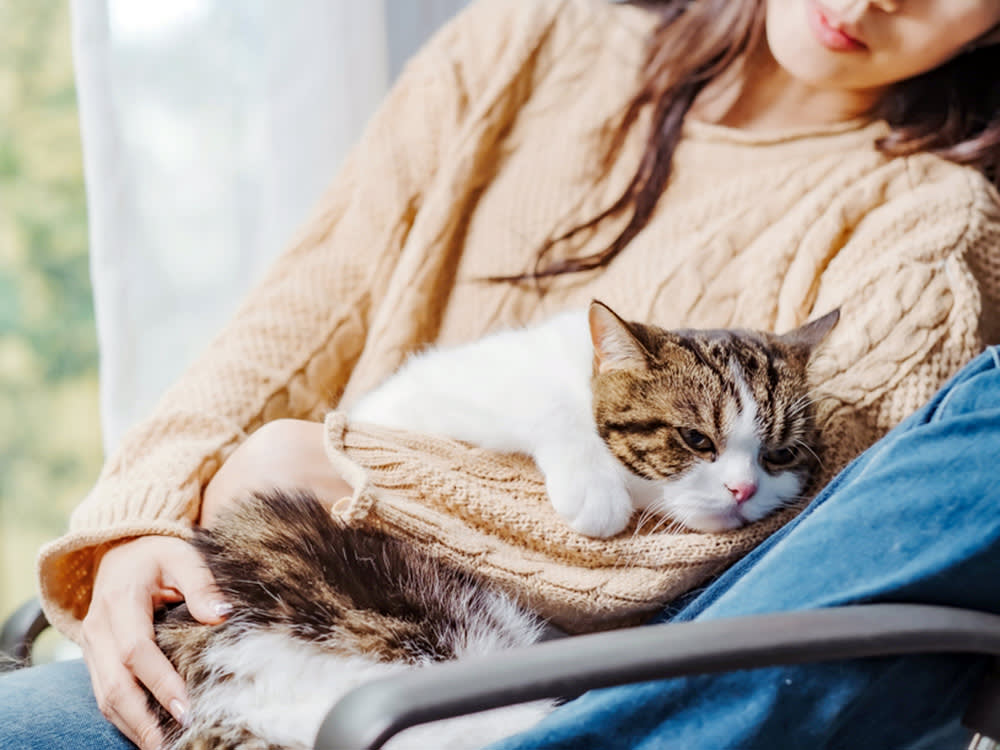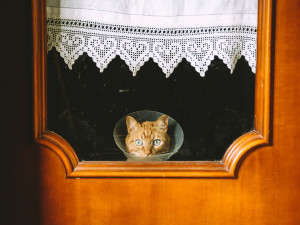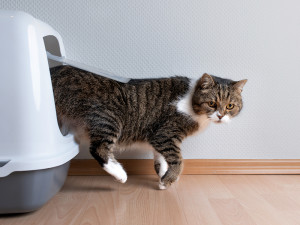Kidney Disease in Cats: Symptoms, Signs, and Treatments
If you notice some of these things, talk to your vet.

share article
In This Article:
Symptoms of Kidney Disease in Cats opens in a new tab Causes of Kidney Disease in Catsopens in a new tab Stages of Feline Kidney Diseaseopens in a new tab Diagnostic Testing Treatments for Kidney Disease opens in a new tab When to Consider Euthanasiaopens in a new tab
Chronic kidney disease in cats typically develops slowly over time, leading to symptoms like increased thirst and urination, weight loss, vomiting, or poor coat condition. Managing a cat’s kidney disease often requires frequent checkups, medications, and the occasional hospital stay.
What do a cat’s kidneys do?
A cat’s kidneys have many important roles in maintaining a cat’s health, including:
Filtering waste from the blood
Maintaining water and electrolyte balance in the body
Regulating blood pressure
Stimulating red blood cell production
As cats age, their kidney function can naturally decline, leading to chronic kidney disease (CKD). While CKD is more common in senior cats, it can also affect younger cats, due to congenital or acquired causes.
Symptoms of kidney disease in cats
The signs of kidney disease in cats can vary depending on the severity of disease, but they tend to be non-specific. Common symptoms include:
Increased urination (polyuria)
Increased thirstopens in a new tab (polydipsia)
Poor appetite
Weight loss
Lethargy
Bad breath
Abdominal pain
Poor coat quality
Causes of kidney disease in cats
Cat parents worried about their sick kitty may wonder what causes kidney disease in cats. Kidney disease can be divided into two groups: acute and chronic. Acute kidney disease can result from a sudden injury to the kidneys. Possible causes of acute kidney disease include infection, toxins (like lilies or antifreeze), and urinary obstructions. Kidneys can often recover from acute injury with prompt treatment, but that is not always the case. Acute kidney disease can sometimes result in chronic kidney disease.
Chronic kidney disease can be divided into two groups: acquired and congenital. Acute kidney injury can lead to CKD if the kidneys don’t fully recover. Other acquired causes include viral infections (like feline infectious peritonitis), some medications, and chronically high blood pressure. The degeneration of kidney function associated with old ageopens in a new tab is also considered an acquired cause of CKD.
Congenital causes of CKD occur during development and impact kidney function at some point in a cat’s life. One of the most common congenital causes of CKD in cats is polycystic kidney disease. Polycystic kidney disease in cats is a genetic disease that results in the development of multiple cysts (pockets of fluid) in the kidneys. The number and size of cysts vary by cat, but the cysts slowly grow and eventually replace normal kidney tissue, leading to kidney failure. Polycystic kidney disease is most commonly diagnosed in Persian catsopens in a new tab.
Stages of feline kidney disease
After a cat is diagnosed with chronic kidney disease (CKD), a veterinarian will use a cat’s clinical condition along with diagnostic testing to determine the stage of the disease. Oftentimes, vets will use the staging system developed by the International Renal Interest Society (IRIS), which breaks the disease down into four stages. This system only applies to cats with chronic kidney disease.
Stage 1
This is early stage kidney disease in cats. Cats may not have noticeable symptoms. Preventative measures may be implemented, like encouraging water intake to ensure hydration.
Stage 2
Stage 2 kidney disease in cats involves mild kidney disease. These cats may require occasional treatment for mild nausea or inappetence. If not done already, a prescription diet may be introduced to reduce strain on the kidneys and slow the progression of disease.
Stage 3
In this stage of feline chronic kidney disease, symptoms become more obvious and frequent. Cats may need routine intervention like subcutaneous fluids.
Stage 4
This is severe kidney disease. Cats with Stage 4 kidney disease develop significant symptoms and complications that require intensive veterinary care.
End Stage
While not a numbered stage in the IRIS system, it’s often a turning point in treatment goals. Cats with end-stage kidney no longer respond to treatments in a meaningful way, and their quality of life continues to decline.
Diagnostic testing for kidney disease in cats
Diagnosing and staging kidney disease in cats relies on diagnostic tests: blood work, urinalysis, and blood pressure measurement. These tests help a veterinarian assess a cat’s kidney function and identify complications commonly associated with kidney disease.
Blood work
Blood urea nitrogen (BUN): A waste product of protein breakdown that is eliminated by the kidneys
Creatinine: A waste product from the breakdown of protein and muscle tissue
Creatinine is used to determine how well the kidneys are filtering waste
SDMA: Considered a sensitive and early marker for detecting a decrease in kidney function
Phosphorus: Important for maintaining calcium levels and cell structure in the body. Phosphorus levels often increase as kidney function declines
Electrolytes (sodium, chloride, potassium): Kidney disease can cause an imbalance of fluid and electrolytes, which can impact other bodily functions
Red blood cell count: Erythropoietin, a hormone secreted by the kidneys, stimulates RBC production. Poor kidney function can lead to anemia
Urinalysis
Urine specific gravity (USG): Indicates how concentrated or dilute urine is. Well-functioning kidneys should be able to conserve water and adequately concentrate urine
Urine sediment: Microscopic inspection to look for bacteria, crystals, or abnormal cells in the urine
Urine protein to creatinine ratio (UPC): Indicates how much protein is leaking into the urine
Urine culture
Urine culture checks for the presence and type of bacteria in the urine.
Blood pressure measurement
High blood pressure can be a complication of kidney disease and can further damage the kidneys.
Imaging
Radiographs: Can help assess the size and shape of the kidneys as well as identify stones in the urinary tract
Ultrasound: Provides a more detailed view of the kidneys and can help detect abnormal structures like cysts or tumors
Treatments for kidney disease
Chronic kidney disease is a progressive condition with no cure, so treatment is aimed at reducing clinical signs and slowing the progression of disease. Treating kidney disease in cats involves a combination of hydration, dietary management, and medications.
Ensure adequate hydration
In early kidney disease, maintaining hydration includes strategies to encourage voluntary water like providing a cat water fountainopens in a new tab. Some cats require intermittent or routine subcutaneous fluids to provide a hydration boost. Cats with severe dehydration or blood work abnormalities often require hospitalization for intravenous fluids.
Make dietary adjustments
Prescription kidney diets are formulated to be restricted in protein and phosphorus, which helps reduce the kidneys’ workload. Not all cats are fans of the flavors of therapeutic diets and will quickly turn their noses up at special food, so gradual diet changes are recommended.
Give recommended medications
Cats with kidney disease may develop issues that require various (long and short-term) medications, including:
Antibiotics for urinary tract infectionopens in a new tab
Blood pressure medication
Anti-nausea medication
Appetite stimulants
Phosphorus binders
Monitor closely
Cats with kidney disease require more frequent checkups for lab work and blood pressure monitoring. Close monitoring of lab values allows your vet to determine if your cat is responding appropriately to treatment or if the disease has progressed enough to warrant a change in treatment regimen. Cat parents should also keep a watchful eye on litter box habits and food and water intake at home.
Seek aggressive care when needed
In situations where cats face severe complications from kidney disease, care beyond outpatient treatment may be needed. Cat parents may need to seek immediate careopens in a new tab if their cat with CKD is anorexic, vomiting, painful, weak, or suddenly blind. Hospitalization might be required for procedures like blood transfusions or aggressive supportive care. Dialysis and kidney transplants have been performed in cats, but these treatments are not commonly pursued because of the expense, equipment, expertise, and risks involved.
When to consider euthanasia
Making an end-of-life decision for a beloved kitty with kidney disease can be challenging. Even with ideal care, chronic kidney disease will progress to a point where symptoms are severe, response to treatment is inadequate, and the overall quality of life diminishes. Some cats become so ill that it's clear that euthanasia will save them from suffering. But for those cats experiencing a mix of good and bad days (though leaning towards more challenging days), the decision-making process may take some time and consideration.
For a more objective approach, pet parents can use the quality of life scale, like the HHHHHMM Scaleopens in a new tab. The letters stand for Hurt, Hunger, Hydration, Hygiene, Happiness, Mobility, and “More good days than bad days.” These factors are used to assign a score to a pet’s quality of life. Another resource is Lap of Love’s Quality of Life Assessmentopens in a new tab website.
When to euthanize a cat with kidney disease is a decision to be made thoughtfully, and your veterinarian can help guide you through it.
FAQs (People also ask):
What is polycystic kidney disease in cats?
Polycystic disease in cats is a genetic disease that results in the development of multiple cysts (pockets of fluid) in the kidneys. The cysts slowly replace normal kidney tissue, eventually leading to kidney failure.
How long can cats live with kidney disease?
Cats can live many years with chronic kidney disease. A cat’s life expectancyopens in a new tab varies greatly depending on how early the kidney disease was diagnosed, how a cat has responded to treatment, and complications that have developed along the way.
What are the stages of kidney disease in cats?
The International Renal Interest Society (IRIS) breaks chronic kidney disease down into four stages: Stages 1-4. Cats with Stage 1 CKD have mild disease with no symptoms, while cats with Stage 4 CKD may require hospitalization for intensive care.
Resources:

Dr. Alycia Washington, DVM, MS
Alycia Washington, DVM, is a small animal emergency veterinarian based in North Carolina. She works as a relief veterinarianopens in a new tab and provides services to numerous emergency and specialty hospitals. Dr. Washington is also a children’s book author and freelance writer with a focus on veterinary medicine. She has a special fondness for turtles, honey bees, and penguins — none of which she treats. In her free time, Dr. Washington enjoys travel, good food, and good enough coffee.
Related articles
![Cat eating out of a red bowl]() opens in a new tab
opens in a new tabDoes Your Diabetic Cat Need a Special Diet?
Get ready for a sigh of relief — this food doesn’t have to be pricey.
![A senior cat is held in their owner's lap]() opens in a new tab
opens in a new tabHow to Care for Your Senior Cat
From taking them to the vet more often to giving them a hand with grooming, older kitties need a little extra TLC.
![Two senior cats laying on a couch]() opens in a new tab
opens in a new tabWhy Senior Cats Make the Best Roommates
Kitten, please! I adopted a couple of seniors because cats, like wine, only get better with age.
![cat coming out of litter box]() opens in a new tab
opens in a new tabWhat to Do When Your Cat Refuses to Be (Litter) Boxed In
A cat behaviorist explains why they are so particular about where they pop a squat.
![Young beautiful woman cuddling with little snow bengal kitten on the bed.]() opens in a new tab
opens in a new tab15 Terms You Should Know When Choosing a Pet Insurance Plan
Overwhelmed by all the small print and jargon? We've got you.
![A woman in a bright yellow-orange sweater holding a striped kitten in one hand and a credit card in the other while using her laptop in front of her]() opens in a new tab
opens in a new tabCan’t Pay Your Pet’s Vet Bills? These Orgs Can Help
When the bills rack up, these resources have your back.











